Revision Notes: Climate of India | Geography Class 10 ICSE PDF Download
| Table of contents |

|
| Climate of India and Regional Variations |

|
| Factors Affecting the Climate of India |

|
| Phenomena and Mechanism of the Monsoons |

|
| Seasons in India |

|
| Distribution of Rainfall |

|
Climate of India and Regional Variations
- India experiences a tropical monsoon climate due to its location in the tropical belt and the influence of monsoon winds. This climate is characterized by hot summers and dry winters.
- The Himalayas play a crucial role in shaping India's climate. They protect northern India from cold winds blowing from Central Asia. Without this mountain range, the Indian plains would face extremely cold temperatures.
- The presence of the Himalayas also gives northern India a continental type of climate, which features hot summers, cold winters, and limited rainfall. Additionally, the diurnal temperature range (the difference between maximum and minimum temperatures) is quite large in this region.
Regional Variations

India spans a wide range of latitudes and longitudes, resulting in significant regional variations in climate. Some examples include:
- Temperature Extremes: In June, Barmer, Rajasthan, can experience scorching temperatures between 48°C and 50°C, while Pahalgam, Kashmir, enjoys a much cooler temperature of around 22°C.
- Climate Types: Kerala has a tropical climate characterized by warm and moist air, whereas Punjab experiences a continental climate with intense heat in the summer and severe cold in the winter.
- Winter Temperatures: In winter, Kerala's temperatures hover around 20°C to 22°C, while in Kargil, temperatures can plummet below -40°C.
- Diurnal Temperature Range: Kerala has a small difference between day and night temperatures, typically around 7°C to 8°C. In contrast, the Thar Desert experiences a large diurnal temperature range, with differences between day and night temperatures ranging from 25°C to 30°C.
- Precipitation: Precipitation patterns also vary widely. In the Himalayas, precipitation often falls as snow, while other parts of the country experience rainfall. For instance, Mawsynram and Cherrapunji in Meghalaya receive about 1100 cm of rainfall annually, whereas Jaisalmer in Rajasthan receives only about 9 cm of rainfall each year.
- Rainfall Distribution: Most of India receives rainfall from June to September, but the coastal areas of Tamil Nadu experience winter rainfall.
Factors Affecting the Climate of India
The Himalayas
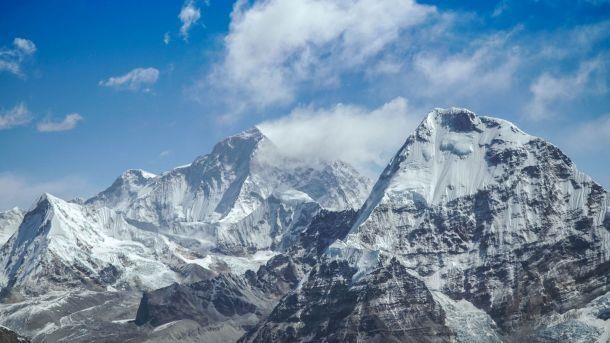
- The Himalayas act as a barrier, protecting the North Indian Plains from harsh cold winds that blow in from Central Asia during the winter months.
- These mountains are crucial for weather patterns in the region. The rain-bearing winds that come from the Arabian Sea bring rainfall to the northern plains after they hit the Himalayas.
- This is because the mountains force the moisture-laden winds to rise, cool, and release their precipitation.
- On the other hand, Central Asia is located in the rain shadow area of the Himalayas, which means it receives very little precipitation from these winds.
The Monsoon Winds
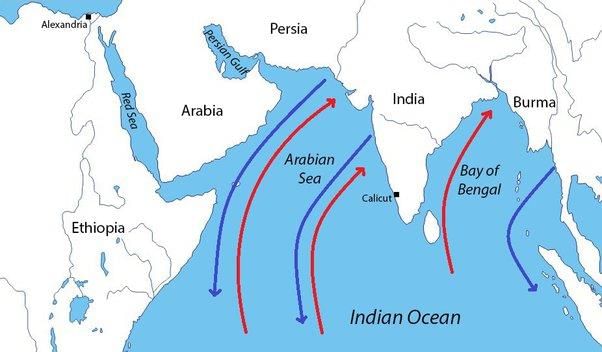
- The monsoon winds play a vital role in shaping the climate of India.
- During the months of June, July, and August, the southwest monsoon winds, originating from the Arabian Sea and the Bay of Bengal, bring widespread rainfall across the entire country.
- As October approaches, these winds begin to retreat from central India.
- In the winter months, the northeast monsoon winds provide additional rainfall to Tamil Nadu.
Latitude
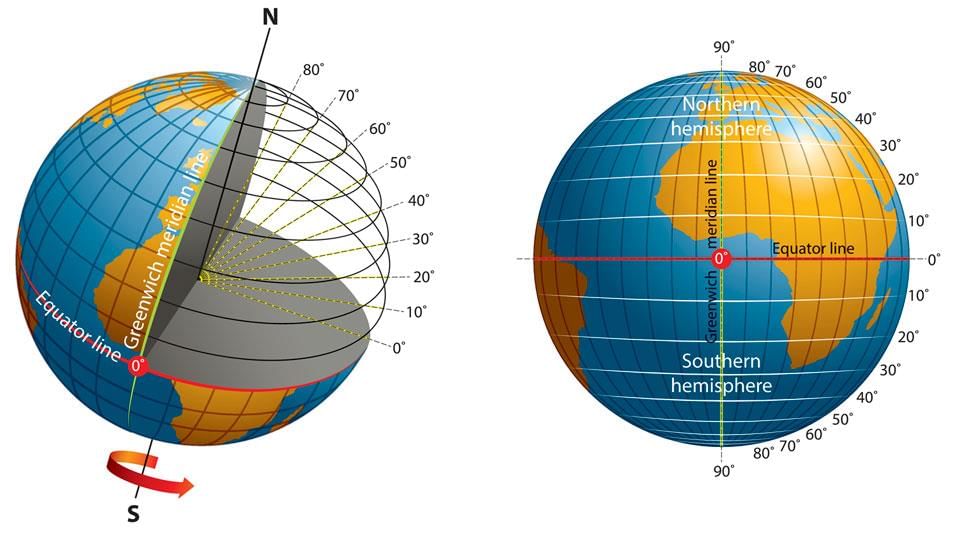
The Tropic of Cancer divides India into two climatic zones:
- The northern part, situated in the temperate zone, experiences hot summers and cool winters.
- The southern part, located in the tropical zone, has a consistently hot climate.
Varied Relief
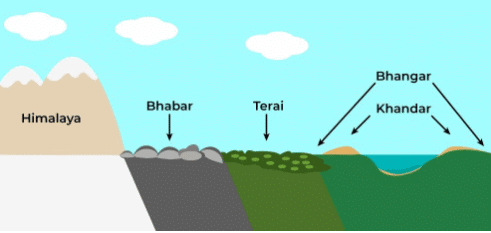
Relief features significantly influence India's climate.
- Areas on the windward side of the Western Ghats receive heavy rainfall, while the Deccan region, on the leeward or rain shadow side, receives very little rainfall.
- Southwest monsoon winds blow parallel to the Aravalli Range, which does not block these moisture-laden winds, resulting in Rajasthan being a dry state.
- In southern Assam, areas receive heavy rainfall because the hills block the winds and force them to release their moisture. By the time these winds reach northern Assam, they are relatively dry.
Factors Affecting Temperature
1. Altitude
- As altitude increases, temperature decreases. Specifically, there is a drop of 1°C for every 166 meters of elevation.
- This is why mountains are cooler than plains. For example, Ooty, which is at a higher altitude, has a lower temperature than Kochi.
2. Influence of the Surrounding Seas
- India is a peninsular country, bordered by seas and oceans on three sides.
- These water bodies influence the climate of regions close to the sea, resulting in a moderate, equable, and maritime climate in those areas.
3. Western Disturbances
- Northern India is affected by western disturbances due to the shifting of pressure belts in central and western Asia.
- These disturbances bring rainfall to northern India and snowfall to regions like Jammu and Kashmir.
Distance from the Sea
- Regions that are far from the sea and located in the interior of the continent experience a continental type of climate.
- In these regions, summers are extremely hot, while winters are very cold.
Phenomena and Mechanism of the Monsoons
Monsoon winds are caused by the difference in heating and cooling between the land and the sea. There are two main types of monsoons: summer monsoon and winter monsoon.
Summer Monsoon
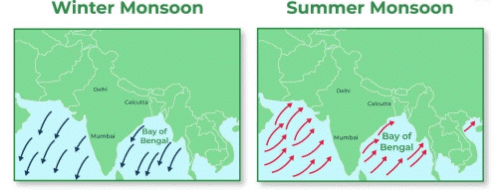
- During the summer, the land heats up quickly, creating low-pressure conditions over the land. Meanwhile, the sea remains relatively cool, leading to high-pressure conditions over the sea.
- Winds naturally move from areas of high pressure to areas of low pressure, so during this time, winds blow from the sea to the land. This phenomenon is known as the summer monsoon.
- In May, June, and July, the plains of the Indian subcontinent receive direct sunlight, further intensifying the low-pressure area over the land and the high-pressure area over the sea.
- As a result, winds blow from the Indian Ocean northwards and northwestwards into Asia. Because these winds originate from the southwest, they are called the southwest summer monsoon.
Winter Monsoon
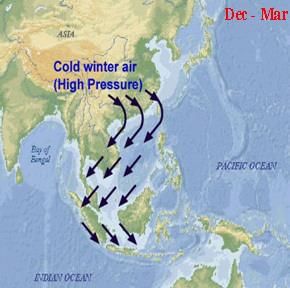
In winter, the pattern of temperatures changes between the land and the oceans. The oceans are relatively warm, while the land cools down. This temperature difference leads to the formation of a high-pressure area over the land and a low-pressure area over the Indian Ocean.
Winds naturally blow from areas of high pressure to areas of low pressure. In this case, the winds blow from the land to the sea. These winds are dry because they originate from the land, which lacks moisture. As a result, they bring cold weather and do not produce any rainfall.
However, when these dry winds blow over the adjacent oceans, they pick up moisture from the water. This process adds humidity to the winds, and as they continue to travel, they bring rainfall to specific areas. The southern Coromandel Coast, which is part of coastal Tamil Nadu, and the southern tip of Andhra Pradesh are the regions that receive this rainfall due to the winter monsoon.
These winds are called northeast monsoon winds because they originate from the northeastern parts of India. Despite being dry when they leave the land, they become moisture-laden and bring precipitation to the coastal areas as they cross the oceans.
Characteristics of Rainfall in India
- Rainfall in India is predominantly observed during the months of July, August, and September.
- The nature of rainfall in India is mainly orographic. Areas located on the windward side of the mountains receive significantly more rainfall compared to those on the leeward side.
- Only a small fraction of rainfall is contributed by cyclones and convectional processes.
- The monsoon in India is characterized by its erratic, uneven, and unpredictable nature. While some regions experience severe floods, others face drought conditions.
Seasons in India
- The southern monsoon winds exhibit distinct seasonal patterns. In regions with a monsoon climate, the year is typically divided into four seasons.
Hot Dry Summer
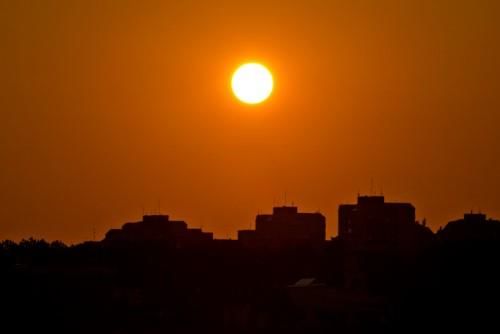
- Summer in India spans from March to May.
- The highest temperatures are recorded in the northwestern parts of the country, where temperatures can soar up to 48°C. In contrast, South India experiences milder temperatures due to the moderating influence of the sea.
- During the summer months, a local hot wind known as "loo" blows across the northern regions of India. Direct exposure to this wind can be dangerous.
- This season also brings thunderstorms called "kalbaisakhi" to West Bengal, which are also referred to as Bardoli Chheerha. These thunderstorms are accompanied by heavy rainfall. Additionally, coastal regions of Kerala and Karnataka experience rainfall during this time, known as "mango showers" because they facilitate the early ripening of mangoes. In Karnataka, these showers are also called "cherry blossoms."
Southwest Monsoon
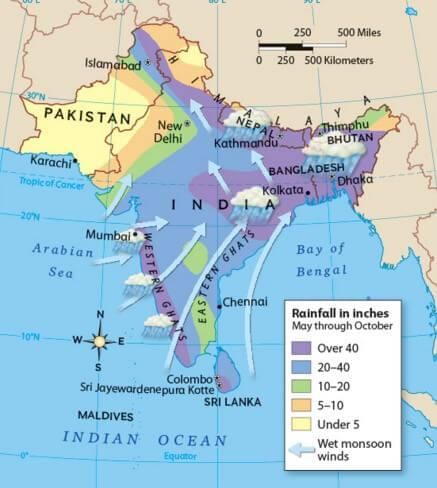
- The southwest monsoon occurs from June to September. During the summer, a low-pressure area forms over the northwestern part of the Indian Ocean, drawing in the southeast trade winds. These winds are deflected to the right by the Coriolis force after crossing the equator.
- When these winds reach the west coast, they bring heavy rainfall along with intense thunder and lightning. This sudden and violent onset of the monsoon is known as the "burst of the monsoon."
- The monsoon winds are divided into two main branches: (i) Arabian Sea branch and (ii) Bay of Bengal branch
Arabian Sea Branch
- One branch of the Arabian Sea monsoon winds brings heavy rainfall to the windward side of the Western Ghats and the Western Coastal Plains. In contrast, the areas on the leeward side of the Western Ghats receive very little rainfall.
- The second branch of the Arabian Sea monsoon winds hits the northern coast of Mumbai, moves along the river valleys of Narmada and Tapti, and causes rainfall in central India. This branch eventually merges with the Bay of Bengal branch after entering the Ganga plains.
- The third branch of the Arabian Sea monsoon strikes the Saurashtra Peninsula and Kachchh, then travels to western Rajasthan, running parallel to the Aravalli Range. As a result, western Rajasthan receives very little rainfall.
- The Arabian Sea branch eventually joins the Bay of Bengal branch, causing rainfall in the western Himalayas.
Bay of Bengal Branch
The Bay of Bengal branch of the southwest monsoon approaches India from Myanmar and southeast Bangladesh. Due to the presence of the Arakan Hills, this branch is deflected towards the Indian subcontinent. As a result, the monsoon enters West Bengal from the south and southeast, rather than from the southwesterly direction.
This branch then splits into two parts: one part runs along the Ganga plains, and the other runs along the Brahmaputra valley.
These branches bring heavy rainfall to the Ganga plains, Brahmaputra valley, and the Garo and Khasi Hills of Meghalaya. Mawsynram and Cherrapunji, located on the southern part of the Khasi Range, receive the highest average rainfall in the world.
The rainfall from the southwest monsoon winds is greatly influenced by topography. For example:
- Mahabaleshwar, located on the windward side of the Western Ghats, receives heavy rainfall (around 250 cm).
- Pune, situated on the leeward side, gets less than 70 cm of rainfall annually.
The northeastern parts of India experience heavy rainfall due to the presence of mountain ranges. There is a gradual decrease in rainfall from east to west as the winds lose their moisture during their journey. For instance, Kolkata receives 120 cm of rainfall, Patna gets 102 cm, Allahabad receives 91 cm, and Delhi gets 56 cm of rainfall.
The coast of Tamil Nadu does not receive rainfall during this season because it is located parallel to the Bay of Bengal branch of the southwest monsoon winds. Additionally, it lies in the rain shadow area of the Arabian Sea branch of the southwest monsoon.
Retreating Monsoon
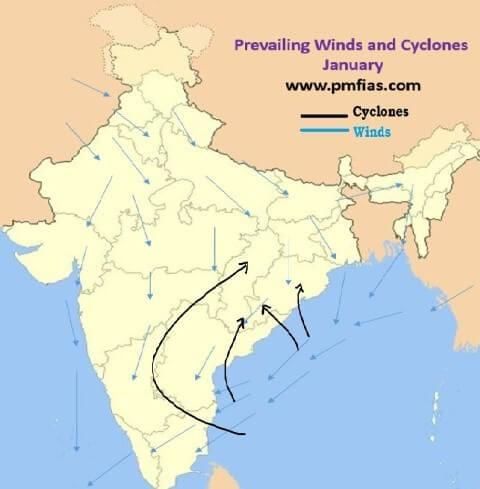
- In the months of October and November, the southwest monsoon winds weaken and begin to retreat.
- During this period, the northern plains experience clear skies and a rise in temperature.
- This increase in temperature, known as October heat, occurs as the monsoon retreats.
- As the monsoon withdraws, low-pressure conditions shift to the Bay of Bengal, leading to the formation of cyclonic depressions.
- These cyclonic depressions can cause significant damage to life and property, particularly along the eastern and southern coasts of India.
- The Coromandel Coast, for example, receives most of its rainfall from these depressions and cyclones.
Tropical Cyclones
- Tropical depressions that form in the Bay of Bengal are triggered by local variations in heat and moisture.
- These depressions can develop into tropical cyclones during the months of November and December.
- Typically, these storms originate near the Andaman and Nicobar Islands, within the latitude range of 12°N to 17°N, and then move eastward into the Bay of Bengal.
- These tropical cyclones bring heavy rainfall and can cause considerable loss of life and property.
October Heat
- October is characterized by a clear, cloudless sky, high temperatures, and elevated humidity levels.
- This phenomenon is referred to as October heat.
- The month of October also serves as a transitional period between the hot, rainy season and the upcoming cold, dry season.
Cold Season

The cold weather season in India starts in mid-November in the northern region and lasts until February, with December and January being the coldest months.
- Temperature Variation: The temperature decreases from south to north. For example, in January, Thiruvananthapuram has a mean temperature of 31°C, while Varanasi experiences only 16°C.
- Reasons for Excessive Cold in North India:
- Cold winds from the Caspian Sea and Turkmenistan affect the northwestern parts of India in February.
- Regions like Punjab, Haryana, and Rajasthan are far from the sea's moderating influence, resulting in a continental climate.
- Snowfall in the nearby Himalayan ranges contributes to cold wave conditions.
- High-pressure conditions over northwestern India intensify the cold.
- Northeast Trade Winds: During this season, these winds blow from land to sea, making them dry. They pick up moisture over the oceans, bringing rainfall to the Coromandel Coast.
- Western Disturbances: These weather phenomena occur in the northern parts of the country during the cold season.
Rainfall
General Pattern: Most of the country does not receive rainfall during winter.
Areas Receiving Winter Rainfall:
- Central and Northern India: Occasional rainfall due to weak temperate cyclones benefiting rabi crops in regions like Delhi, Haryana, Punjab, and Western Uttar Pradesh.
- Northeastern India: Receives winter rainfall.
- Northeast Monsoon: In October and November, this monsoon picks up moisture over the Bay of Bengal, causing heavy rainfall along the coast of Tamil Nadu and the southern tip of Andhra Pradesh.
Distribution of Rainfall
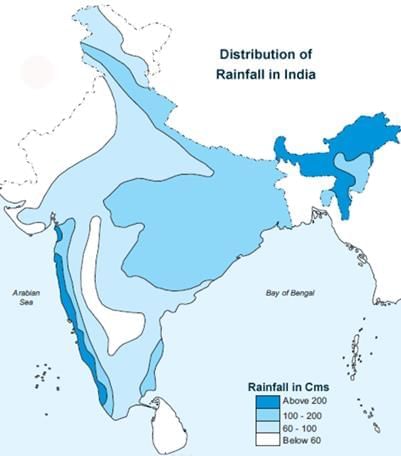
Factors Determining Rainfall Distribution:
- Pressure Conditions: The atmospheric pressure influences the formation and movement of weather systems that bring rain.
- Direction of Relief Features: The presence and orientation of mountains and hills can affect how moisture-laden winds are lifted, leading to rainfall.
- Direction of Moisture-Laden Winds: Winds carrying moisture from oceans or other water bodies play a crucial role in bringing rain to different regions.
- Cyclonic Depression: Areas of low pressure, or cyclonic depressions, created by pressure gradients, can lead to the development of storms that bring heavy rainfall.
Rainfall Distribution in India
Heavy Rainfall Areas (more than 200 cm)
- Slopes of the Western Ghats and the Western Coastal Plains
- Meghalaya Hills (Garo, Khasi, and Jaintia), southern slopes of the Eastern Himalayas, Assam, Arunachal Pradesh, and West Bengal
Moderate Rainfall Areas (100–200 cm)
- Southern parts of Tamil Nadu and northern parts of Andhra Pradesh
- Middle Ganga Valley, parts of the Western Ghats, Eastern Maharashtra, Madhya Pradesh, and Odisha
Low Rainfall Areas (50–100 cm)
- Deccan Plateau regions in Karnataka, Andhra Pradesh, and Tamil Nadu
- Eastern Rajasthan, Punjab, Haryana, and Kashmir
Scanty Rainfall Areas (less than 50 cm)
- Northern Kashmir, southern Punjab, and western Rajasthan
- Rain shadow regions of the Western Ghats in the Deccan Plateau
|
33 videos|148 docs|20 tests
|
FAQs on Revision Notes: Climate of India - Geography Class 10 ICSE
| 1. What are the main factors affecting the climate of India? |  |
| 2. How do the Himalayas impact the climate of India? |  |
| 3. What is the significance of monsoon winds in India's climate? |  |
| 4. How does latitude affect the temperature in India? |  |
| 5. What role does distance from the sea play in the climate of India? |  |















